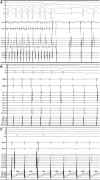Arrhythmia Termination Versus Elimination of Dormant Pulmonary Vein Conduction as a Procedural End Point of Catheter Ablation for Paroxysmal Atrial Fibrillation: A Prospective Randomized Trial
- PMID: 26297786
- PMCID: PMC4608486
- DOI: 10.1161/CIRCEP.115.002786
Arrhythmia Termination Versus Elimination of Dormant Pulmonary Vein Conduction as a Procedural End Point of Catheter Ablation for Paroxysmal Atrial Fibrillation: A Prospective Randomized Trial
Abstract
Background: Pulmonary vein isolation (PVI) is still associated with a substantial number of arrhythmia recurrences in paroxysmal atrial fibrillation (AF). This prospective, randomized study aimed to compare 2 different procedural strategies.
Methods and results: A total of 152 patients undergoing de novo ablation for paroxysmal AF were randomized to 2 different treatment arms. The procedure in group A consisted of PVI exclusively. In this group, all isolated PVs were challenged with adenosine to reveal and ablate dormant conduction. In group B, PVI was performed with the patient either in spontaneous or in induced AF. If AF did not terminate with PVI, ablation was continued by targeting extra-PV AF sources with the desired procedural end point of termination to sinus rhythm. Primary study end point was freedom from arrhythmia during 1-year follow-up. In group A, adenosine provoked dormant conduction in 31 (41%) patients with a mean of 1.6±0.8 transiently recovered PVs per patient. Termination of AF during PVI was observed in 31 (65%) patients, whereas AF persisted afterward in 17 (35%) patients. AF termination occurred in 13 (76%) patients by AF source ablation. After 1-year follow-up, significantly more group B patients were free of arrhythmia recurrences (87 versus 68%; P=0.006). During redo ablation, the rate of PV reconduction did not differ between both groups (group A: 55% versus group B: 61%; P=0.25).
Conclusions: Elimination of extra-PV AF sources after PVI is superior to sole PV isolation with the adjunct of abolishing potential dormant conduction.
Clinical trial registration: URL: http://www.clinicaltrials.gov. Unique identifier: NCT02238392.
Keywords: arrhythmias, cardiac; atrial fibrillation; catheter ablation; follow-up studies; pulmonary veins.
© 2015 The Authors.
Figures



References
-
- Cappato R, Negroni S, Pecora D, Bentivegna S, Lupo PP, Carolei A, Esposito C, Furlanello F, De Ambroggi L. Prospective assessment of late conduction recurrence across radiofrequency lesions producing electrical disconnection at the pulmonary vein ostium in patients with atrial fibrillation. Circulation. 2003;108:1599–1604. doi: 10.1161/01.CIR.0000091081.19465.F1. - PubMed
-
- Cappato R, Calkins H, Chen SA, Davies W, Iesaka Y, Kalman J, Kim YH, Klein G, Natale A, Packer D, Skanes A, Ambrogi F, Biganzoli E. Updated worldwide survey on the methods, efficacy, and safety of catheter ablation for human atrial fibrillation. Circ Arrhythm Electrophysiol. 2010;3:32–38. doi: 10.1161/CIRCEP.109.859116. - PubMed
-
- Nanthakumar K, Plumb VJ, Epstein AE, Veenhuyzen GD, Link D, Kay GN. Resumption of electrical conduction in previously isolated pulmonary veins: rationale for a different strategy? Circulation. 2004;109:1226–1229. doi: 10.1161/01.CIR.0000121423.78120.49. - PubMed
-
- Verma A, Mantovan R, Macle L, De Martino G, Chen J, Morillo CA, Novak P, Calzolari V, Guerra PG, Nair G, Torrecilla EG, Khaykin Y. Substrate and Trigger Ablation for Reduction of Atrial Fibrillation (STAR AF): a randomized, multicentre, international trial. Eur Heart J. 2010;31:1344–1356. doi: 10.1093/eurheartj/ehq041. - PMC - PubMed
-
- Oral H, Pappone C, Chugh A, Good E, Bogun F, Pelosi F, Jr, Bates ER, Lehmann MH, Vicedomini G, Augello G, Agricola E, Sala S, Santinelli V, Morady F. Circumferential pulmonary-vein ablation for chronic atrial fibrillation. N Engl J Med. 2006;354:934–941. doi: 10.1056/NEJMoa050955. - PubMed
Publication types
MeSH terms
Substances
Associated data
LinkOut - more resources
Full Text Sources
Medical
Research Materials

